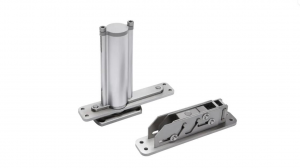When designing spaces that connect indoors and outdoors—like patios, decks, or sunrooms—or dividing open-concept areas, two popular door options often emerge: pivot doors and multi-slide doors. Both offer unique benefits, but they’re suited to different needs, spaces, and design goals. Let’s start with clear definitions: A pivot door rotates around a central pivot point (top/bottom or central), while a multi-slide door consists of multiple panels that slide along a track, stacking or disappearing into a wall cavity. As SMED, a door hinge manufacturer with over 20 years of experience and ISO 9000 certification, I’ve helped countless clients choose between these two options. In this article, I’ll compare them across key factors to help you decide which is right for your project.
Space: Pivot Door Swing vs. Sliding Panels
Space is one of the most critical factors when choosing between pivot and multi-slide doors. Pivot doors require clearance for swinging: because they rotate in a circular motion, they need empty space around the door frame (both inside and outside) to open fully. This means they’re not ideal for tight spaces—for example, a narrow patio where a swinging pivot door might hit furniture or block walkways. However, pivot doors don’t require a track, which keeps floor spaces clean and unobstructed. Multi-slide doors, by contrast, need wall or cavity space for panel storage: when opened, their panels slide along a track and stack against a wall or disappear into a built-in cavity. This means they need no swing clearance, making them perfect for small spaces. But the track can be a drawback—some homeowners dislike the raised track (which can be a tripping hazard) or the need to keep the track clean for smooth operation. Our door pivot hinges factory often recommends pivot doors for spaces with ample clearance and multi-slide doors for compact areas.
View & Light: Glass Size, Frame Visibility
For spaces where views and natural light are priorities—like oceanfront homes or rooms with garden views—both doors perform well, but with key differences. Pivot doors can accommodate large, single-panel glass, which means fewer frames and an unobstructed view. A floor-to-ceiling glass pivot door creates a “picture window” effect when closed, maximizing light and visibility. The minimal hardware (thanks to concealed pivot hinges) further enhances this, as there are no side hinges to break the view. Multi-slide doors, while they also use glass, have more frames—each panel needs its own frame, which can create a “grid” effect that disrupts the view. However, multi-slide doors can cover wider openings: while pivot doors typically max out at 5-6 feet wide, multi-slide doors can span 10 feet or more by adding panels. This means they can let in more total light, even with the extra frames. Our stainless steel pivot hinge is designed to support large glass pivot panels, ensuring they remain stable while preserving the view.
Cost & Installation: Compare Investment and Maintenance
Cost and maintenance are practical considerations that often tip the scales. Pivot doors generally have a lower upfront cost: a single pivot door panel is less expensive to manufacture than multiple slide panels, and installation is simpler (no need to build wall cavities or install complex track systems). Our door pivot hinges factory offers cost-effective hinge solutions, further reducing the overall investment. Maintenance for pivot doors is also easier: they have fewer moving parts, and our stainless steel pivot hinges resist rust and wear, requiring only occasional cleaning. Multi-slide doors, by contrast, are more expensive upfront: the multiple panels, track system, and wall cavity (if needed) add to the cost. Installation is also more labor-intensive, as the track must be perfectly level to ensure smooth sliding. Maintenance is more involved too: the track can collect dirt and debris, which can cause panels to stick, and the sliding hardware may need periodic lubrication or adjustment. For budget-conscious projects or those seeking low-maintenance options, pivot doors are often the better choice.
Best Use Cases: Where Each Type Works Best
The best door type depends on your project’s specific use case. Pivot doors excel in: entryways (front doors or interior doors leading to bedrooms/offices), where their dramatic look and wide opening create a welcoming feel; medium-sized openings (4-6 feet wide), where a single pivot panel is sufficient; spaces with ample clearance, like large patios or open-concept living rooms. Multi-slide doors are better for: wide openings (8+ feet wide), where multiple panels can span the space; tight spaces, like narrow balconies or small sunrooms, where swing clearance is limited; Indoor-outdoor integration, like poolside areas or decks, where stacking panels can fully open the space.
Conclusion
In the end, choosing between a pivot door and a multi-slide door comes down to your space, priorities, and budget. If you have ample clearance, want a dramatic look, and prefer lower cost and maintenance, go with a pivot door. If you need to cover a wide opening, have limited space, and don’t mind higher costs, a multi-slide door is the way to go. Our team’s professional engineers ensure our hinges are durable, smooth-operating, and tailored to your project—helping you create a door system that meets your exact needs, while aligning with our vision to improve human living scenarios through reliable hardware.
